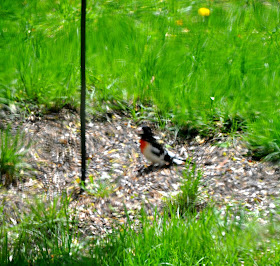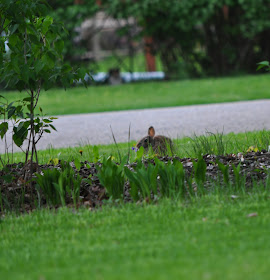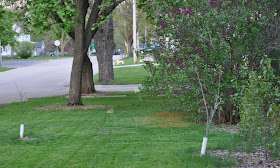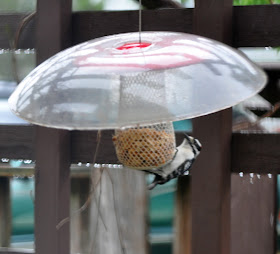The great experiment is about to begin and here is my armory.
First let me say, I have no problem with the squirrels sharing in the bounty of a bird feeder. I do have a little problem when they just curl round the bottom tray of the feeder, lounge there, and then chomp away until the feeder is empty.
Squirrels aren't terrifically good about sharing. It just doesn't appear to be in their natures.
Three days ago it was raining and as I stood looking out at this particular feeder, I noted that one of the squirrels who regularly raids the bird feeder on the South West side of the house was having a bit of trouble climbing the pole to get to the feeder.
Interesting. The new variable on that day was, of course, the soaking rain and the pole which holds the feeder was dripping wet.
Now Squirrel wasn't exactly sliding down during the ascent but she had to make a point of really gripping the pole tightly with whichever set of of paws were holding her up when moving the other set. And sometimes she had to freeze and grip tight with both sets of appendages for a second not to slide back down.
Ordinarily the squirrels go up this pole with the speed in which they go up trees.
Zip!
Yes, I have tried a baffle on the pole but it tips so they use that as an advantage. Pop over the edge and TA DA!
But the very wet pole was slowing her down.
Hmmm. I wonder what would happen if I greased the pole.
(Tee hee.)
Interesting experiment.
But wouldn't the grease attract bugs?
Very likely but many species of birds love to nab and eat insects, particularly during nesting season. Therefore it would improve the birdie buffet, right?
Therefore today when I went out to fill that particular feeder, I filled my containers with seed as usual but also grabbed a wad of paper towels, and the Crisco can.
No I am NOT going to use some icky black car grease or something that isn't at least somewhat eatable. Don't want them licking their paws clean and getting sick.
And as I wanted the best result possible, I really laid the Crisco on heavily. You could actually see white globs of it stuck to the pole in places.
I did this at about noon. And guess what? There was still seed in the feeders at the end of the day.
Unfortunately I didn't see a squirrel try to climb the pole. Perhaps all the squirrels were raiding someone else's feeder today?
Ordinarily though they keep an eye peeled and hit this feeder within an hour of it being filled. Therefore the Goldfinch, who, for whatever reason only eat at this particular feeder, have to be even more vigilant to get any seed at all.
Could this actually be working? All the devices, and expensive commercial products one buys to defend feeders from squirrel invasions are all mostly clap trap as the squirrels always figure a way to evade them. Even the ones that close when squirrel weight hits the perch bar...though it takes them longer to come up with a balancing solution that keeps them off the bar and it does tend to inconvenience them.
Is is possible that all one really has to do is grease the pole?
It does seem too good to be true. But so far so good.
We'll see.
Oh. Don't worry that my squirrels might go hungry...they have their own feeding station that includes cobs of corn and other squirrel fare.
And besides...
Tomorrow is another day. And squirrels much like parrots love a good puzzle and find WINNING extremely important.
Oh! I almost forgot, the Bleeding Hearts are in bloom.
P.S. See the plant in the left of the frame. It is terribly familiar but I just can't come up with its name. If you recognize it please drop me an email.
Donegal Browne
Thursday, May 05, 2016
Tuesday, May 03, 2016
Bunny, a Rose-breasted Grosbeak, and a Very Unexpected Great Blue Heron Meal
For two days Bunny has changed her point of view by hanging out in the FRONT yard under the lilacs.
And one of the Rose-breasted Grosbeaks has decided that the feeder on the west side of the house is better than the busier feeders on the east side. Unfortunately the wavy glass in this window is even wavier the ones overlooking the other feeding area. Due to the window glass, the seed area in front of him looks downright psychedelic.
Grosbeaks really do have heavy duty beaks.
Grosbeak is finishing up a sunflower seed, when suddenly...
He leaps into the air and bugs out. ??? Giving us a great view of his under wing color patches on the way. But what's the emergency?
The emergency turns out to be a Red-winged Blackbird who was determined to take Grosbeak's spot under the feeder.
Next up.... from longtime reader and contributor Betty Jo McDonald.
Did you know that Great Blue Heron's eat gophers?
We didn't either.
Check out the link below for a video of the aforementioned activity.
See the bunny, center, under the lilac trees. Look for ears. Well when I first spied the bunny there were two. The second under the lilac (far right) with the bare limbs close to the ground.
When I returned, second Bunny had taken a powder. DRAT!
Wait! There she is. This bunny looks like the one we've seen before. We'll call her Mom Bunny for now. Originally I'd thought the first bunny looked smallish.
And here's Mom. She's letting me walk round her from a distance.
That's our original Bunny from the last few weeks. See the very distinct "eyebrow" and the rufous fur on the nap of her neck?
That's her alright.
I'm carefully walking round at a distance in order to possibly get another picture of the original rabbit in the lilacs. I hear planes over head.
I look up for a moment to check out the aircraft.
When I look down again, both rabbits are gone. Like successful prey animals they pay attention to the "predators" eyes.
So when I looked up at the planes, the rabbits took their chance and skedaddled.
And last but not least, the fascinating video by Jesse Garza of a Great Blue Heron eating something quite unexpected, discovered by longtime reader and contributor Betty Jo McDonald of California.
Happy Hawking!
Donegal Browne
Sunday, May 01, 2016
A DigiStellascope of Pale Male's Mate Octavia and an Eyass, Plus The Stealthy Bunny
Stella Hamilton and her Stellascope at the Hawk Bench in Central Park come through again! Octavia stands on the Fifth Avenue Nest with a little white eyass head in front of her left (to us) foot!
Bunny or as we have decided she is a female, technically the Doe Cottontail Rabbit has been scarce the last two days which have been decidedly rainy and cold. Temperatures were in the mid 30's yesterday and mid 40's today. Therefore she is likely spending more time in the den keeping the probable "kittens" or "kits" for short, warm.
I find it interesting that rabbits don't have specific to species names for the male and female, the male and female are the same as deer, and the young are the same as cats.
Today has not been spectacular for photographically nabbing the most interesting birds at the feeders.
While making my way through the laundry/parrot room without my camera, I saw two male Rose-breasted Grosbeaks with several white albinistic feathers where there completely black area feathers should be. I headed back to the next room to get the camera but by the time I got back all I saw were tail feathers as they hot winged it over the fence and through the pine tree never to be seen again...at least by me today.
Chipmunk was using an interesting technique to fill his pouches today in the rain saturated feeding area beneath the birds feeders. He jammed his nose down into the sediment.
And then vigorously chewed his way down filling his cheek pouches as he went.
White-crowned Sparrow hopped his way down the less mucky bricks past the spontaneously appearing orange fungi. Sorry about the blur. Not only are we dealing with that 1850's wavy glass, the glass was wet besides.
One of the Nuthatches was availing himself of the nut feeder. He was peaking away to retrieve a piece large enough to hatch into some bark, or the house, or the fence. When he managed it he took off to hatch it into a favorite spot.
Three Grackles showed up and strutted around the area for awhile. They always remind me of some kind of avian Storm Troopers.
Then one of the male Downy Woodpeckers arrive. They tend to grip the bottom edge and then brace themselves with their amazingly stiff tall feathers which tends to start the feeder swinging.
See his feathers blowing.
And there goes the feeder like a spinning pendulum.
And round he spins again!
Lets hope the weather clears up tomorrow so the raptor nests can be seen clearly enough for some updates.
Donegal Browne
Bunny or as we have decided she is a female, technically the Doe Cottontail Rabbit has been scarce the last two days which have been decidedly rainy and cold. Temperatures were in the mid 30's yesterday and mid 40's today. Therefore she is likely spending more time in the den keeping the probable "kittens" or "kits" for short, warm.
I find it interesting that rabbits don't have specific to species names for the male and female, the male and female are the same as deer, and the young are the same as cats.
Today has not been spectacular for photographically nabbing the most interesting birds at the feeders.
While making my way through the laundry/parrot room without my camera, I saw two male Rose-breasted Grosbeaks with several white albinistic feathers where there completely black area feathers should be. I headed back to the next room to get the camera but by the time I got back all I saw were tail feathers as they hot winged it over the fence and through the pine tree never to be seen again...at least by me today.
Chipmunk was using an interesting technique to fill his pouches today in the rain saturated feeding area beneath the birds feeders. He jammed his nose down into the sediment.
And then vigorously chewed his way down filling his cheek pouches as he went.
White-crowned Sparrow hopped his way down the less mucky bricks past the spontaneously appearing orange fungi. Sorry about the blur. Not only are we dealing with that 1850's wavy glass, the glass was wet besides.
One of the Nuthatches was availing himself of the nut feeder. He was peaking away to retrieve a piece large enough to hatch into some bark, or the house, or the fence. When he managed it he took off to hatch it into a favorite spot.
Three Grackles showed up and strutted around the area for awhile. They always remind me of some kind of avian Storm Troopers.
Then one of the male Downy Woodpeckers arrive. They tend to grip the bottom edge and then brace themselves with their amazingly stiff tall feathers which tends to start the feeder swinging.
See his feathers blowing.
And there goes the feeder like a spinning pendulum.
And round he spins again!
Lets hope the weather clears up tomorrow so the raptor nests can be seen clearly enough for some updates.
Donegal Browne



























